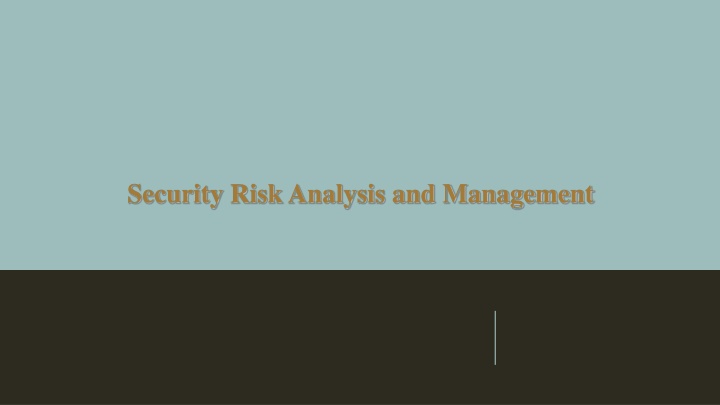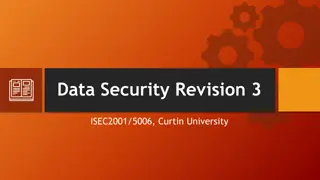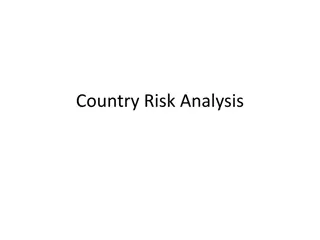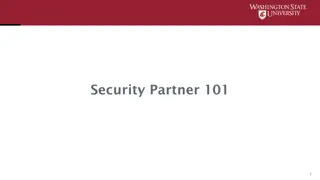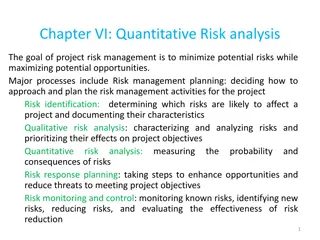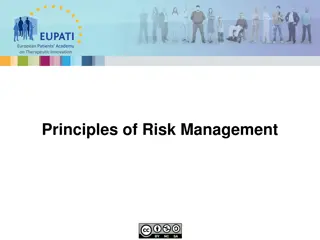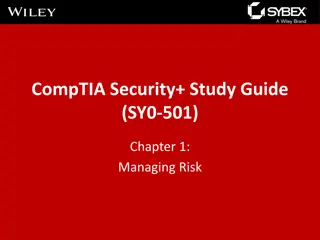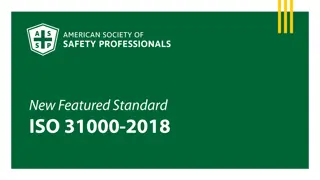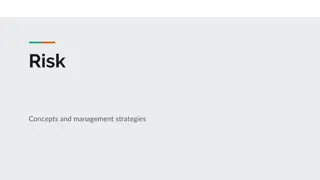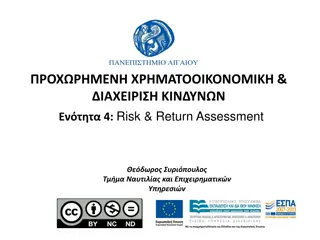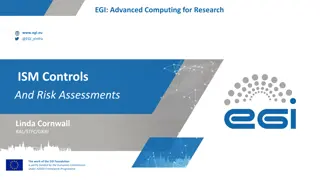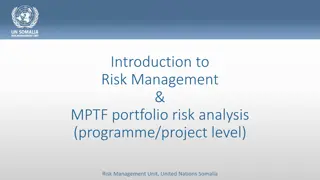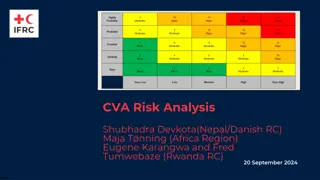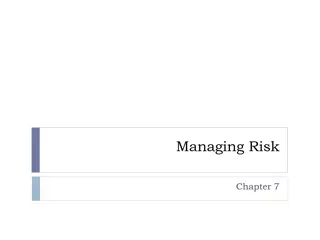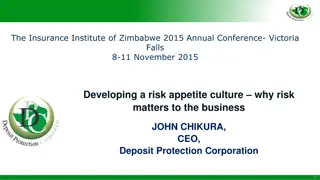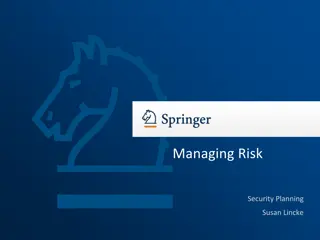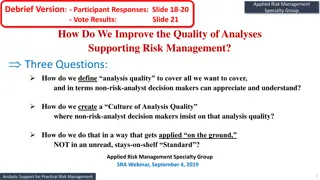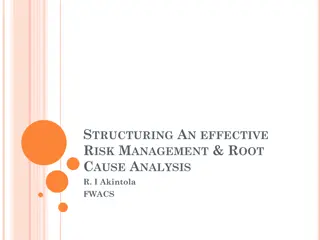Comprehensive Overview of Security Risk Analysis and Management
Explore the essential aspects of security risk analysis and management, including risk identification, assessment, and control techniques within an Information Security (InfoSec) context. Learn about the purpose of risk management, steps involved in a risk management plan, asset identification and categorization, threat assessment, and risk prioritization strategies to safeguard business assets and maintain a secure environment.
Download Presentation

Please find below an Image/Link to download the presentation.
The content on the website is provided AS IS for your information and personal use only. It may not be sold, licensed, or shared on other websites without obtaining consent from the author.If you encounter any issues during the download, it is possible that the publisher has removed the file from their server.
You are allowed to download the files provided on this website for personal or commercial use, subject to the condition that they are used lawfully. All files are the property of their respective owners.
The content on the website is provided AS IS for your information and personal use only. It may not be sold, licensed, or shared on other websites without obtaining consent from the author.
E N D
Presentation Transcript
RISK MANAGEMENT: CONTROLLING RISK IN INFORMATION SECURITY
THE PURPOSE OF RISK MANAGEMENT Ensure overall business and business assets are safe Protect against competitive disadvantage Compliance with laws and best business practices Maintain a good public reputation
STEPS OF A RISK MANAGEMENT PLAN Step 1: Identify Risk Step 2: Assess Risk Step 3: Control Risk Steps are similar regardless of context (InfoSec, Physical Security, Financial, etc.) This presentation will focus on controlling risk within an InfoSec context
Asset Asset Type and Subcategory Asset Function Priority Level (Low, Medium, High, Critical) RISK IDENTIFICATION Bob Worker Personnel: InfoSec Secure Networks Penetration Testing Make coffee Low The steps to risk identification are: Identify your organization s information assets Classify and categorize said assets into useful groups Rank assets necessity to the organization To the right is a simplified example of how a company may identify risks Cisco UCS B460 M4 Blade Server Hardware: Networking Database Server High Customer Personally Identifiable Information (PII) Data: Confidential Information Provide information for all business transactions Critical Windows 7 Software: Operating System Employee access to enterprise software Medium
Threat Agent and Threat Targeted Asset Threat Level Possible Exploits Risk (Scale of 1-5) RISK ASSESSMENT The steps to risk assessment are: Identify threats and threat agents Prioritize threats and threat agents Assess vulnerabilities in current InfoSec plan Determine risk of each threat R = P * V M + U R = Risk P = Probability of threat attack V = Value of Information Asset M = Mitigation by current controls U = Uncertainty of vulnerability The table to the right combines elements of all of these in a highly simplified format Disgruntled Insider: Steal company information to sell Company data (i.e. Customer PII) High Access control credentials, knowledge of InfoSec policies, etc. 4.16 Fire: Burn the facility down or cause major damage Company Facility, Personnel, Equipment Critical Mishandled equipment 2.78 Hacktivists: Quality of service deviation Company Hardware/ Software Low Lack of effective filtering 1.39
RISK CONTROL The steps to risk control are: Cost-Benefit Analysis (CBA) Single Loss Expectancy (SLE) Annualized Rate of Occurrence (ARO) Annual Loss Expectancy (ALE) Annual Cost of the Safeguard (ASG) Feasibility Analysis Organizational Feasibility Operational Feasibility Technical Feasibility Political Feasibility Risk Control Strategy Implementation
VULNERABILITY ASSESSMENT (CONTD.) Single loss expectancy (SLE) Expected monetary loss each time a risk occurs Calculated by multiplying the asset value by exposure factor Exposure factor: percentage of asset value likely to be destroyed by a particular risk Security+ Guide to Network Security Fundamentals, Fourth Edition 8
VULNERABILITY ASSESSMENT (CONTD.) Annualized loss expectancy (ALE) Expected monetary loss over a one year period Multiply SLE by annualized rate of occurrence Annualized rate of occurrence (ARO) : probability that a risk will occur in a particular year It can be calculated by multiplying the annual rate of occurrence (ARO) by single loss expectancy (SLE). Security+ Guide to Network Security Fundamentals, Fourth Edition 9
Suppose that an asset is valued at $100,000, and the Exposure Factor (EF) for this asset is 25%. The single loss expectancy (SLE) then, is 25% * $100,000, or $25,000. For an annual rate of occurrence of one, the annualized loss expectancy is 1 * $25,000, or $25,000. Security+ Guide to Network Security Fundamentals, Fourth Edition 10
Security+ Guide to Network Security Fundamentals, Fourth Edition 11
COST-BENEFIT ANALYSIS Determine what risk control strategies are cost effective Below are some common formulas used to calculate cost-benefit analysis SLE = AV * EF AV = Asset Value, EF = Exposure factor (% of asset affected) ALE = SLE * ARO CBA = ALE (pre-control) ALE (post- control) ASG
FEASIBILITY ANALYSIS Organizational: Does the plan correspond to the organization s objectives? What is in it for the organization? Does it limit the organization s capabilities in any way? Operational: Will shareholders (users, managers, etc.) be able/willing to accept the plan? Is the system compatible with the new changes? Have the possible changes been communicated to the employees? Technical: Is the necessary technology owned or obtainable? Are our employees trained and if not can we afford to train them? Should we hire new employees? Political: Can InfoSec acquire the necessary budget and approval to implement the plan? Is the budget required justifiable? Does InfoSec have to compete with other departments to acquire the desired budget?
RISK CONTROL STRATEGIES Defense Transferal Mitigation Acceptance (Abandonment) Termination
RISK CONTROL STRATEGY: DEFENSE Defense: Prevent the exploitation of the system via application of policy, training/education, and technology. Preferably layered security (defense in depth) Counter threats Remove vulnerabilities from assess Limit access to assets Add protective safeguards
RISK CONTROL STRATEGY: TRANSFERAL Transferal: Shift risks to other areas or outside entities to handle Can include: Purchasing insurance Outsourcing to other organizations Implementing service contracts with providers Revising deployment models
RISK CONTROL STRATEGY: MITIGATION Mitigation: Creating plans and preparations to reduce the damage of threat actualization Preparation should include a: Incidence Response Plan Disaster Recovery Plan Business Continuity Plan
RISK CONTROL STRATEGY: ACCEPTANCE Acceptance: Properly identifying and acknowledging risks, and choosing to not control them Appropriate when: The cost to protect an asset or assets exceeds the cost to replace it/them When the probability of risk is very low and the asset is of low priority Otherwise acceptance = negligence
RISK CONTROL STRATEGY: TERMINATION Termination: Removing or discontinuing the information asset from the organization Examples include: Equipment disposal Discontinuing a provided service Firing an employee
PROS AND CONS OF EACH STRATEGY Pros Cons Defense: Preferred all round approach Defense: Expensive and laborious Transferal: Easy and effective Transferal: Dependence on external entities Mitigation: Effective when all else fails Mitigation: Guarantees company loss Acceptance: Cheap and easy Acceptance: Rarely appropriate, unsafe Termination: Relatively cheap and safe Termination: Rarely appropriate, requires company loss
STANDARD APPROACHES TO RISK MANAGEMENT U.S CERT s Operationally Critical Threat Assessment Vulnerability Evaluation (OCTAVE) Methods (Original, OCTAVE-S, OCTAVE-Allegro) ISO 27005 Standard for InfoSec Risk Management NIST Risk Management Model Microsoft Risk Management Approach Jack A. Jones Factor Analysis of Information Risk (FAIR) Delphi Technique
RISK MANAGEMENT SOFTWARE https://www.youtube.com/watch?v=lUZy7je-nMY
